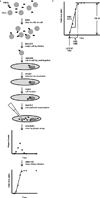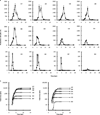Kinetics of virus production from single cells
- PMID: 22222212
- PMCID: PMC3268887
- DOI: 10.1016/j.virol.2011.12.005
Kinetics of virus production from single cells
Abstract
The production of virus by infected cells is an essential process for the spread and persistence of viral diseases, the effectiveness of live-viral vaccines, and the manufacture of viruses for diverse applications. Yet despite its importance, methods to precisely measure virus production from cells are lacking. Most methods test infected-cell populations, masking how individual cells behave. Here we measured the kinetics of virus production from single cells. We combined simple steps of liquid-phase infection, serial dilution, centrifugation, and harvesting, without specialized equipment, to track the production of virus particles from BHK cells infected with vesicular stomatitis virus. Remarkably, cell-to-cell differences in latent times to virus release were within a factor of two, while production rates and virus yields spanned over 300-fold, highlighting an extreme diversity in virus production for cells from the same population. These findings have fundamental and technological implications for health and disease.
Copyright © 2011 Elsevier Inc. All rights reserved.
Figures




References
-
- Burnet F. A Method for the Study of Bacteriophage Multiplication in Broth. Brit. J. Expt. Path. 1929;10(2):109–114.
-
- Condra JH, Schleif WA, Blahy OM, Gabryelski LJ, Graham DJ, Quintero JC, Rhodes A, Robbins HL, Roth E, Shivaprakash M, et al. In vivo emergence of HIV-1 variants resistant to multiple protease inhibitors. Nature. 1995;374(6522):569–571. - PubMed
-
- Cuevas JM, Moya A, Sanjuan R. Following the very initial growth of biological RNA viral clones. J Gen Virol. 2005;86(Pt 2):435–443. - PubMed
-
- Delbrück M. The burst size distribution in the growth of bacterial viruses (bacteriophages) J. Bact. 1945;50:131–135. - PubMed
-
- Domingo E, Martinez-Salas E, Sobrino F, Torre JCdl, Portela A, Ortin J, Lopez-Galindez C, Perez-Brena P, Villanueva N, Najera R, VandePol S, Steinhauer D, DePolo N, Holland J. The quasispecies (extremely heterogeneous) nature of viral RNA genome populations: biological relevance- a review. Gene. 1985;40:1–8. - PubMed
Publication types
MeSH terms
Grants and funding
LinkOut - more resources
Full Text Sources
Other Literature Sources

